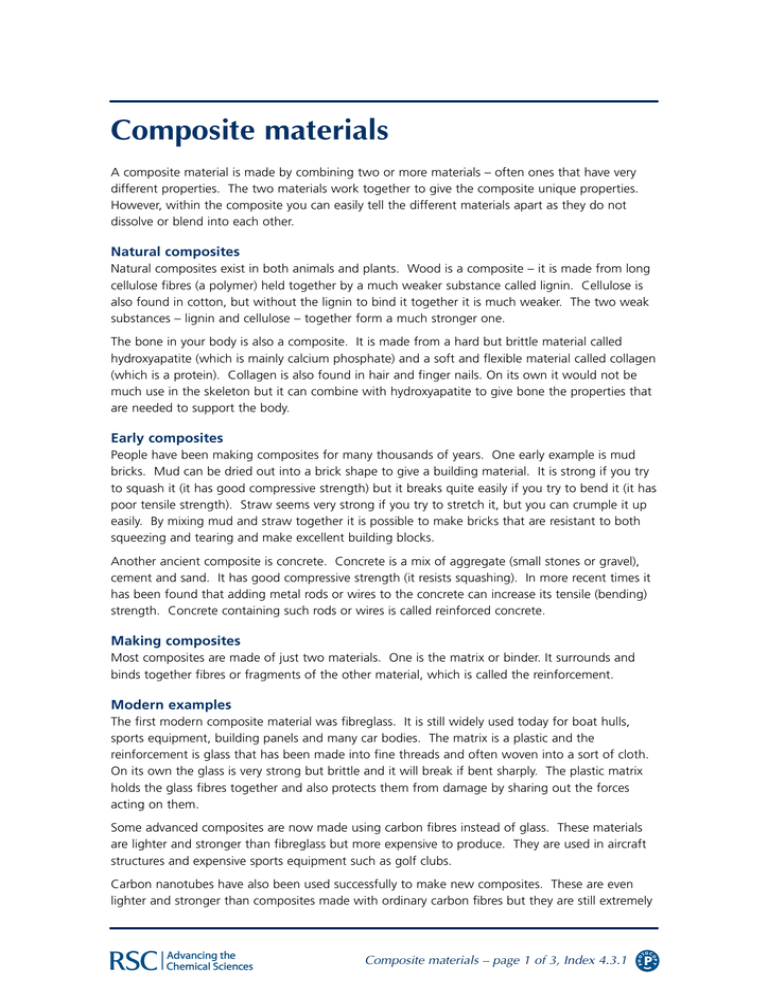Composite materials
advertisement

Composite materials A composite material is made by combining two or more materials – often ones that have very different properties. The two materials work together to give the composite unique properties. However, within the composite you can easily tell the different materials apart as they do not dissolve or blend into each other. Natural composites Natural composites exist in both animals and plants. Wood is a composite – it is made from long cellulose fibres (a polymer) held together by a much weaker substance called lignin. Cellulose is also found in cotton, but without the lignin to bind it together it is much weaker. The two weak substances – lignin and cellulose – together form a much stronger one. The bone in your body is also a composite. It is made from a hard but brittle material called hydroxyapatite (which is mainly calcium phosphate) and a soft and flexible material called collagen (which is a protein). Collagen is also found in hair and finger nails. On its own it would not be much use in the skeleton but it can combine with hydroxyapatite to give bone the properties that are needed to support the body. Early composites People have been making composites for many thousands of years. One early example is mud bricks. Mud can be dried out into a brick shape to give a building material. It is strong if you try to squash it (it has good compressive strength) but it breaks quite easily if you try to bend it (it has poor tensile strength). Straw seems very strong if you try to stretch it, but you can crumple it up easily. By mixing mud and straw together it is possible to make bricks that are resistant to both squeezing and tearing and make excellent building blocks. Another ancient composite is concrete. Concrete is a mix of aggregate (small stones or gravel), cement and sand. It has good compressive strength (it resists squashing). In more recent times it has been found that adding metal rods or wires to the concrete can increase its tensile (bending) strength. Concrete containing such rods or wires is called reinforced concrete. Making composites Most composites are made of just two materials. One is the matrix or binder. It surrounds and binds together fibres or fragments of the other material, which is called the reinforcement. Modern examples The first modern composite material was fibreglass. It is still widely used today for boat hulls, sports equipment, building panels and many car bodies. The matrix is a plastic and the reinforcement is glass that has been made into fine threads and often woven into a sort of cloth. On its own the glass is very strong but brittle and it will break if bent sharply. The plastic matrix holds the glass fibres together and also protects them from damage by sharing out the forces acting on them. Some advanced composites are now made using carbon fibres instead of glass. These materials are lighter and stronger than fibreglass but more expensive to produce. They are used in aircraft structures and expensive sports equipment such as golf clubs. Carbon nanotubes have also been used successfully to make new composites. These are even lighter and stronger than composites made with ordinary carbon fibres but they are still extremely P Y PHO TO C OP Composite materials – page 1 of 3, Index 4.3.1 expensive. They do, however, offer possibilities for making lighter cars and aircraft (which will use less fuel than the heavier vehicles we have now). The new Airbus A380, the world’s largest passenger airliner, makes use of modern composites in its design. More than 20 % of the A380 is made of composite materials, mainly plastic reinforced with carbon fibres. The design is the first large-scale use of glass-fibre-reinforced aluminium, a new composite that is 25 % stronger than conventional airframe aluminium but 20 % lighter. Why use composites? The biggest advantage of modern composite materials is that they are light as well as strong. By choosing an appropriate combination of matrix and reinforcement material, a new material can be made that exactly meets the requirements of a particular application. Composites also provide design flexibility because many of them can be moulded into complex shapes. The downside is often the cost. Although the resulting product is more efficient, the raw materials are often expensive. P Y PHO TO C OP Composite materials – page 2 of 3, Index 4.3.1 Questions 1. What is a composite? ................................................................................................................................................... ................................................................................................................................................... 2. On its own, collagen would not be much use in the skeleton. Explain why not. ................................................................................................................................................... ................................................................................................................................................... 3. Why are composites important in nature? ................................................................................................................................................... ................................................................................................................................................... 4. What is the matrix and what is the reinforcement in: mud bricks? ................................................................................................................................................... a. concrete? ................................................................................................................................................... b. 5. List four modern composites and give a use for each. Try to include some which are not mentioned in the information above. ................................................................................................................................................... ................................................................................................................................................... ................................................................................................................................................... ................................................................................................................................................... 6. Why are composites so important in the design of the Airbus A380? ................................................................................................................................................... 7. How can composite materials help to protect the environment and reduce carbon dioxide emissions in the future? ................................................................................................................................................... ................................................................................................................................................... P Y PHO TO C OP Composite materials – page 3 of 3, Index 4.3.1

